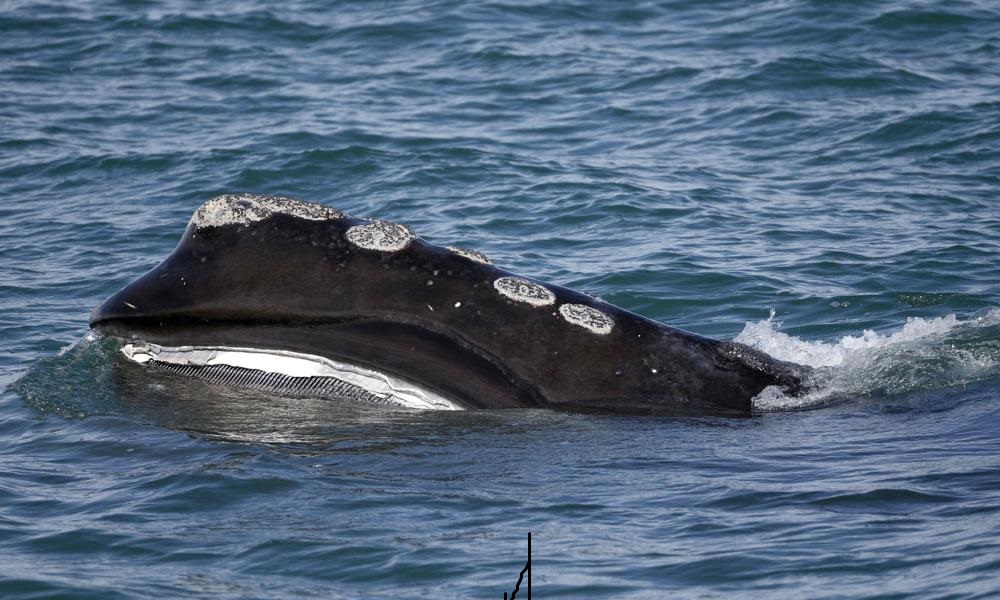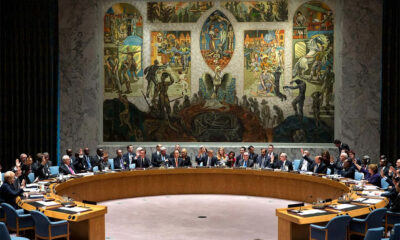Science & Technology
US unveils plan to grow wind power while sparing rare whale

The US federal government has outlined a strategy to try to protect an endangered species of whale while also developing offshore wind power off the East Coast.
President Joe Biden’s administration has made a priority of encouraging offshore wind along the Atlantic coast as the U.S. pursues greater energy independence. Those waters are also home to the declining North Atlantic right whale, which numbers about 340 in the world, AP reported.
The National Oceanic and Atmospheric Administration and the Bureau of Ocean Energy Management released a draft plan this month to conserve the whales while allowing for the building of wind projects. The agencies said the ongoing efforts to save the whales and create more renewable energy can coexist.
“As we face the ongoing challenges of climate change, this strategy provides a strong foundation to help us advance renewable energy while also working to protect and recover North Atlantic right whales, and the ecosystem they depend on,” said Janet Coit, assistant administrator for NOAA Fisheries.
The development of offshore wind is going on along the migratory routes of the whales, which travel from Georgia and Florida to New England and Canada every year. That potentially leaves the whales vulnerable to disturbance or injury. The agencies said they plan to provide offshore wind developers with guidance about mitigation measures to help navigate the regulatory process as part of the whale strategy.
The strategy focuses on “improving the science and integrating past, present and future efforts related to North Atlantic right whales and offshore wind development,” said Jon Hare, the director of NOAA’s Northeast Fisheries Science Center and a lead author on the document. It also identifies mitigation measures related to project planning, leasing and siting, he said.
The right whales have been declining in recent years and face threats such as collisions with ships and entanglement in fishing gear. Environmentalist groups, including the Natural Resources Defense Council, have called for more protections for the whales.
The protection strategy is promising, but it needs funding for implementation and requirements for measures that minimize harm to the whales, said Alison Chase, a senior policy analyst with the council. Those include speed and noise reductions, Chase said.
“We need offshore wind, and we need to do it right,” Chase said. “But as we fight climate change, we must avoid, minimize, and mitigate threats to ocean life in whatever ways we can.”
The government will take public comment on the draft strategy until Dec. 4.
Science & Technology
New iPhone will use Arm’s chip technology for AI
Apple uses Arm’s technology in the process of designing its own custom chips for its iPhones, iPads and Macs.

Apple’s latest iPhone with its A18 chip, which is set to be unveiled at an event on Monday, has been developed using SoftBank-owned Arm’s newest V9 chip design, the Financial Times newspaper reported on Saturday.
Apple is set to host its fall event on Sept. 9 at its headquarters in Cupertino, California, where it will likely unveil a series of new iPhones and updates to other devices and apps, Reuters reported.
Apple signed a deal with Arm in September last year that “extends beyond 2040” in a boost for Arm for chip technology.
Arm had said in July that its V9 chip accounts for 50% of smartphone revenue.
Arm owns the intellectual property behind the computing architecture for most of the world’s smartphones, which it licenses to Apple and many others.
Apple uses Arm’s technology in the process of designing its own custom chips for its iPhones, iPads and Macs.
The two companies have a long history – Apple was one of the initial companies that partnered to found the firm in 1990, before the release of its “Newton” handheld computer in 1993, which used an Arm-based processor chip.
The Newton flopped, but Arm went on to become dominant in mobile phone chips because of its low power consumption, which helps batteries last longer.
Science & Technology
Japan’s military to spend on AI, automation, perks to combat recruitment crisis
To cope with fewer recruits, the ministry said it will introduce artificial intelligence technology, allocating 18 billion yen next year for an AI surveillance system for military base security.

Japan’s defence ministry on Friday said it will invest in AI, automation and improving troop conditions to address a worsening recruitment shortfall that has left its forces understaffed amid a build up aimed at countering China’s growing military power.
The measures, unveiled in its latest defence budget request on Friday, come after the Self Defense Forces’ (SDF) worst ever annual recruitment drive. In the year to March 31 it enrolled just under 10,000 sailors, soldiers and air personnel, half of its target, Reuters reported.
Fearful that China could use military force to bring neighbouring Taiwan under its control and drag Japan into a war, Prime Minister Fumio Kishida in 2022 announced a doubling in defense spending to stock up on missiles and other munitions, pay for advanced fighter jets and create a cyber defence force.
Japan’s falling birth rate, however, mean it is struggling more than ever to maintain current SDF troop levels at 250,000 people.
“As we increase our defensive strength, we need to build an organisation that is able to fight in new ways,” the defence ministry said in the annual budget request, which calls for a 6.9% spending increase to a record 8.5 trillion yen ($59 billion)
To cope with fewer recruits, the ministry said it will introduce artificial intelligence technology, allocating 18 billion yen next year for an AI surveillance system for military base security.
It will also buy more unmanned drones and order three highly-automated air defense warships for 314 billion yen that require only 90 sailors, less than half the crew of current ships.
To free up more troops for frontline assignments the SDF will also outsource some training and support operations to former SDF members and civilian contractors.
And in a bid to tap Japan’s shrinking pool of fighting-age people, who are also being pursued by companies able to pay more, it plans to offer financial incentives and better living conditions, such as sleeping quarters with more privacy and improved access to social media.
In particular, it is focusing on luring more women, who make less than 10% of the SDF. Attempts to boost their number have been hindered by a series of high-profile sexual harassment cases.
To help turn around that effort, Japan’s military wants 16.4 billion yen to build accommodation for female personnel, with improved toilets and showers. It also said it will hire outside councilors to support women and strengthen harassment training.
Science & Technology
Telegram messaging app CEO Durov arrested in France
Russia began blocking Telegram in 2018 after the app refused to comply with a court order to grant state security services access to its users’ encrypted messages.

Pavel Durov, the Russian-French billionaire founder and CEO of the Telegram messaging app, was arrested at Bourget airport outside Paris on Saturday evening, TF1 TV and BFM TV said, citing unidentified sources.
Durov was travelling aboard his private jet, TF1 said on its website, adding he had been targeted by an arrest warrant in France as part of a preliminary police investigation, Reuters reported.
TF1 and BFM both said the investigation was focused on a lack of moderators on Telegram, and that police considered that this situation allowed criminal activity to go on undeterred on the messaging app.
Durov faces possible indictment on Sunday, according to French media.
The encrypted Telegram, with close to one billion users, is particularly influential in Russia, Ukraine and the republics of the former Soviet Union. It is ranked as one of the major social media platforms after Facebook, YouTube, WhatsApp, Instagram, TikTok and Wechat.
Telegram did not immediately respond to a Reuters request for comment. The French Interior Ministry and police had no comment.
Russian-born Durov founded Telegram with his brother in 2013. He left Russia in 2014 after refusing to comply with government demands to shut down opposition communities on his VKontakte social media platform, which he sold.
“I would rather be free than to take orders from anyone,” Durov told U.S. journalist Tucker Carlson in April about his exit from Russia and search for a home for his company which included stints in Berlin, London, Singapore and San Francisco.
After Russia launched its invasion of Ukraine in 2022, Telegram has become the main source of unfiltered – and sometimes graphic and misleading – content from both sides about the war and the politics surrounding the conflict, read the report.
The platform has become what some analysts call ‘a virtual battlefield’ for the war, used heavily by Ukraine’s President Volodymyr Zelenskiy and his officials, as well as the Russian government.
Telegram – which allows users to evade official scrutiny – has also become one of the few places where Russians can access independent news about the war after the Kremlin increased curbs on independent media following its invasion of Ukraine.
The Russian foreign ministry said its embassy in Paris was clarifying the situation around Durov and called on Western non-governmental organisations to demand his release, Reuters reported.
Russia began blocking Telegram in 2018 after the app refused to comply with a court order to grant state security services access to its users’ encrypted messages.
The action interrupted many third-party services, but had little effect on the availability of Telegram there. The ban order, however, sparked mass protests in Moscow and criticism from NGOs.
TF1 said Dubai-based Durov had been travelling from Azerbaijan and was arrested at around 8 p.m. (1800 GMT).
Durov, whose fortune was estimated by Forbes at $15.5 billion, said some governments had sought to pressure him but the app should remain a “neutral platform” and not a “player in geopolitics”.
Telegram’s increasing popularity, however, has prompted scrutiny from several countries in Europe, including France, on security and data breach concerns.
Russia’s representative to international organisations in Vienna, Mikhail Ulyanov, and several other Russian politicians were quick on Sunday to accuse France of acting as a dictatorship – the same criticism that Moscow faced when putting demands on Durov in 2014 and trying to ban Telegram in 2018.
“Some naive persons still don’t understand that if they play more or less visible role in international information space it is not safe for them to visit countries which move towards much more totalitarian societies,” Ulyanov wrote on X.
Elon Musk, billionaire owner of X, the social media platform formerly known as Twitter, said after reports of Durov’s detention: “It’s 2030 in Europe and you’re being executed for liking a meme.”
Robert F. Kennedy Jr, who on Friday abandoned his U.S. presidential campaign and endorsed Republican Donald Trump, said on X after the reports that the need to protect free speech, “has never been more urgent.”
Several Russian bloggers called for protests at French embassies throughout the world at noon on Sunday.
-

 Sport4 days ago
Sport4 days agoKuwait beats Afghanistan 4-3 in five-a-side Futsal tournament match
-

 World5 days ago
World5 days agoUS researchers find probable launch site of Russia’s new nuclear-powered missile
-

 Latest News4 days ago
Latest News4 days agoUN Security Council members ‘divided’ over Afghanistan issue
-

 World5 days ago
World5 days agoBiden says Netanyahu not doing enough to secure hostage deal
-

 Sport3 days ago
Sport3 days agoAfghanistan thrashes New Zealand 5-1 in five-a-side futsal tournament match
-

 Latest News4 days ago
Latest News4 days agoIsraeli attacks in Gaza kill 35 Palestinians but pauses allow third day of polio vaccinations
-

 Sport4 days ago
Sport4 days agoBangladesh sweep test series in Pakistan in healing touch for troubled nation
-

 Latest News3 days ago
Latest News3 days agoDiscussion program launched for journalists and Herat spokesmen






















